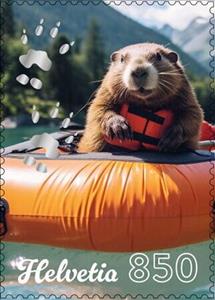Stamp: The Descent of the Aare from Marmi (Switzerland 2024)
The Descent of the Aare from Marmi (Switzerland 2024)
24 April (Switzerland ) within release "Marmi" Crypto Stamp 4.0 – Basic Edition (2024) goes into circulation Stamp The Descent of the Aare from Marmi face value 850 Swiss centime
| Stamp The Descent of the Aare from Marmi in catalogues | |
|---|---|
| Michel: | Mi: CH 2914 |
Stamp is square format.
Stamp from souvenir sheet. Drawing made by AI with MidJourney software. Stamp with NFT. Token ID: 1 Back picture is the digital representation Total value = stamp value 850Ct. + 1.40Fr. for NFT (upper right side)Also in the issue "Marmi" Crypto Stamp 4.0 – Basic Edition (2024):
- Stamp - Marmi Builds a Chalet face value 9.90;
- Stamp - Marmi Conquers the Cross-country Ski Trails face value 9.90;
- Stamp - Marmi Discovers Ice Hockey face value 9.90;
- Stamp - Marmi Dresses up as Santa Claus face value 9.90;
- Stamp - Marmi Eats Fondue face value 9.90;
- Stamp - Marmi Goes Summer Sledding face value 9.90;
- Stamp - Marmi in a Demonstration Cheese Dairy face value 9.90;
- Stamp - Marmi in the Land of Cable Cars face value 9.90;
- Stamp - Marmi in the Land of Walnut Pie face value 9.90;
- Stamp - Marmi in Unspunnen face value 9.90;
- Stamp - Marmi is Curling face value 9.90;
- Stamp - Marmi is Ice Skating face value 9.90;
- Stamp - Marmi is Mountain Biking face value 9.90;
- Stamp - Marmi is Paragliding face value 9.90;
- Stamp - Marmi is Playing Football face value 9.90;
- Stamp - Marmi is Playing Tennis face value 9.90;
- Stamp - Marmi is Skiing face value 9.90;
- Stamp - Marmi is Snowboarding face value 9.90;
- Stamp - Marmi on a Hike face value 9.90;
- Stamp - Marmi Reaches the Summits face value 9.90;
- Stamp - Marmi Sets Sail face value 9.90;
- Stamp - Marmi Swimming in Open Water face value 9.90;
- Stamp - Marmi Travels Comfortably by Train face value 9.90;
- Stamp - The Descent of the Aare from Marmi face value 9.90;
- Stamp - The Descent of the Aare from Marmi face value 850;
Stamp The Descent of the Aare from Marmi it reflects the thematic directions:
Animals are multicellular, eukaryotic organisms of the kingdom Animalia (also called Metazoa). All animals are motile, meaning they can move spontaneously and independently, at some point in their lives. Their body plan eventually becomes fixed as they develop, although some undergo a process of metamorphosis later on in their lives. All animals are heterotrophs: they must ingest other organisms or their products for sustenance.
Crypto-communism (or cryptocommunism) is a secret support for, or admiration of, communism. Individuals and groups have been labelled as crypto-communists, often as a result of being associated with, or influenced by communists. Crypto-communism among political leaders aided the sovietization of the Baltic states.
Mammals are any vertebrates within the class Mammalia (/məˈmeɪli.ə/ from Latin mamma "breast"), a clade of endothermic amniotes distinguished from reptiles (including birds) by the possession of a neocortex (a region of the brain), hair, three middle ear bones and mammary glands. All female mammals nurse their young with milk, secreted from the mammary glands. Mammals include the largest animals on the planet, the great whales. The basic body type is a terrestrial quadruped, but some mammals are adapted for life at sea, in the air, in trees, underground or on two legs. The largest group of mammals, the placentals, have a placenta, which enables the feeding of the fetus during gestation. Mammals range in size from the 30–40 mm (1.2–1.6 in) bumblebee bat to the 30-meter (98 ft) blue whale. With the exception of the five species of monotreme (egg-laying mammals), all modern mammals give birth to live young. Most mammals, including the six most species-rich orders, belong to the placental group. The largest orders are the rodents, bats and Soricomorpha (shrews and allies). The next three biggest orders, depending on the biological classification scheme used, are the Primates (apes and monkeys), the Cetartiodactyla (whales and even-toed ungulates), and the Carnivora (cats, dogs, seals, and allies).


